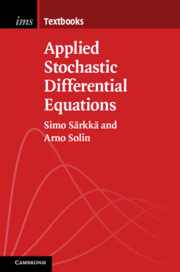Crossref Citations
This Book has been
cited by the following publications. This list is generated based on data provided by Crossref.
Hou, Yuxin
Kannala, Juho
and
Solin, Arno
2019.
Multi-View Stereo by Temporal Nonparametric Fusion.
p.
2651.
Simón, M. A.
Martínez-Garaot, S.
Pons, M.
and
Muga, J. G.
2019.
Asymmetric heat transport in ion crystals.
Physical Review E,
Vol. 100,
Issue. 3,
Lane, M. A.
Matos, D.
Ford, I. J.
and
Kantorovich, L.
2020.
Exactly thermalized quantum dynamics of the spin-boson model coupled to a dissipative environment.
Physical Review B,
Vol. 101,
Issue. 22,
Li, Qing
Godsill, Simon J.
Liang, Jiaming
and
Ahmad, Bashar I.
2020.
Inferring Dynamic Group Leadership Using Sequential Bayesian Methods.
p.
8911.
Maoutsa, Dimitra
Reich, Sebastian
and
Opper, Manfred
2020.
Interacting Particle Solutions of Fokker–Planck Equations Through Gradient–Log–Density Estimation.
Entropy,
Vol. 22,
Issue. 8,
p.
802.
Bae, Jaehan
Jeong, Dong Hwi
and
Lee, Jong Min
2020.
Ranking-Based Parameter Subset Selection for Nonlinear Dynamics with Stochastic Disturbances under Limited Data.
Industrial & Engineering Chemistry Research,
Vol. 59,
Issue. 50,
p.
21854.
Kersting, Hans
Sullivan, T. J.
and
Hennig, Philipp
2020.
Convergence rates of Gaussian ODE filters.
Statistics and Computing,
Vol. 30,
Issue. 6,
p.
1791.
Duchet, Benoit
Weerasinghe, Gihan
Cagnan, Hayriye
Brown, Peter
Bick, Christian
and
Bogacz, Rafal
2020.
Phase-dependence of response curves to deep brain stimulation and their relationship: from essential tremor patient data to a Wilson–Cowan model.
The Journal of Mathematical Neuroscience,
Vol. 10,
Issue. 1,
Kim, Soong‐Ki
and
An, Soon‐Il
2020.
Untangling El Niño‐La Niña Asymmetries Using a Nonlinear Coupled Dynamic Index.
Geophysical Research Letters,
Vol. 47,
Issue. 4,
Rogers, Timothy J.
Worden, Keith
and
Cross, Elizabeth J.
2020.
Bayesian Joint Input-State Estimation for Nonlinear Systems.
Vibration,
Vol. 3,
Issue. 3,
p.
281.
Nayek, Rajdip
and
Narasimhan, Sriram
2020.
Extraction of contact-point response in indirect bridge health monitoring using an input estimation approach.
Journal of Civil Structural Health Monitoring,
Vol. 10,
Issue. 5,
p.
815.
Yu, Bin
Zhong, Guang-Yan
Li, Jiang-Cheng
and
Tang, Nian-Sheng
2021.
Bayesian estimation for stochastic dynamic equations via Fokker–Planck equation.
Modern Physics Letters B,
Vol. 35,
Issue. 03,
p.
2150055.
Watson, Joe
2021.
Reinforcement Learning Algorithms: Analysis and Applications.
Vol. 883,
Issue. ,
p.
189.
Korkidis, Panagiotis
Dounis, Anastasios
and
Kofinas, Panagiotis
2021.
Computational Intelligence Technologies for Occupancy Estimation and Comfort Control in Buildings.
Energies,
Vol. 14,
Issue. 16,
p.
4971.
Zhao, Zheng
Karvonen, Toni
Hostettler, Roland
and
Sarkka, Simo
2021.
Taylor Moment Expansion for Continuous-Discrete Gaussian Filtering.
IEEE Transactions on Automatic Control,
Vol. 66,
Issue. 9,
p.
4460.
Martín-Pasquín, Francisco Javier
and
Pisarchik, Alexander N.
2021.
Brownian Behavior in Coupled Chaotic Oscillators.
Mathematics,
Vol. 9,
Issue. 19,
p.
2503.
Kania, Lucas
Schürch, Manuel
Azzimonti, Dario
and
Benavoli, Alessio
2021.
Machine Learning and Knowledge Discovery in Databases. Research Track.
Vol. 12977,
Issue. ,
p.
527.
Simón, M. A.
Alaña, A.
Pons, M.
Ruiz-García, A.
and
Muga, J. G.
2021.
Heat rectification with a minimal model of two harmonic oscillators.
Physical Review E,
Vol. 103,
Issue. 1,
Tronarp, Filip
Särkkä, Simo
and
Hennig, Philipp
2021.
Bayesian ODE solvers: the maximum a posteriori estimate.
Statistics and Computing,
Vol. 31,
Issue. 3,
Ham, Sang Woo
Karava, Panagiota
Bilionis, Ilias
and
Braun, James
2021.
Real-time model for unit-level heating and cooling energy prediction in multi-family residential housing.
Journal of Building Performance Simulation,
Vol. 14,
Issue. 4,
p.
420.



